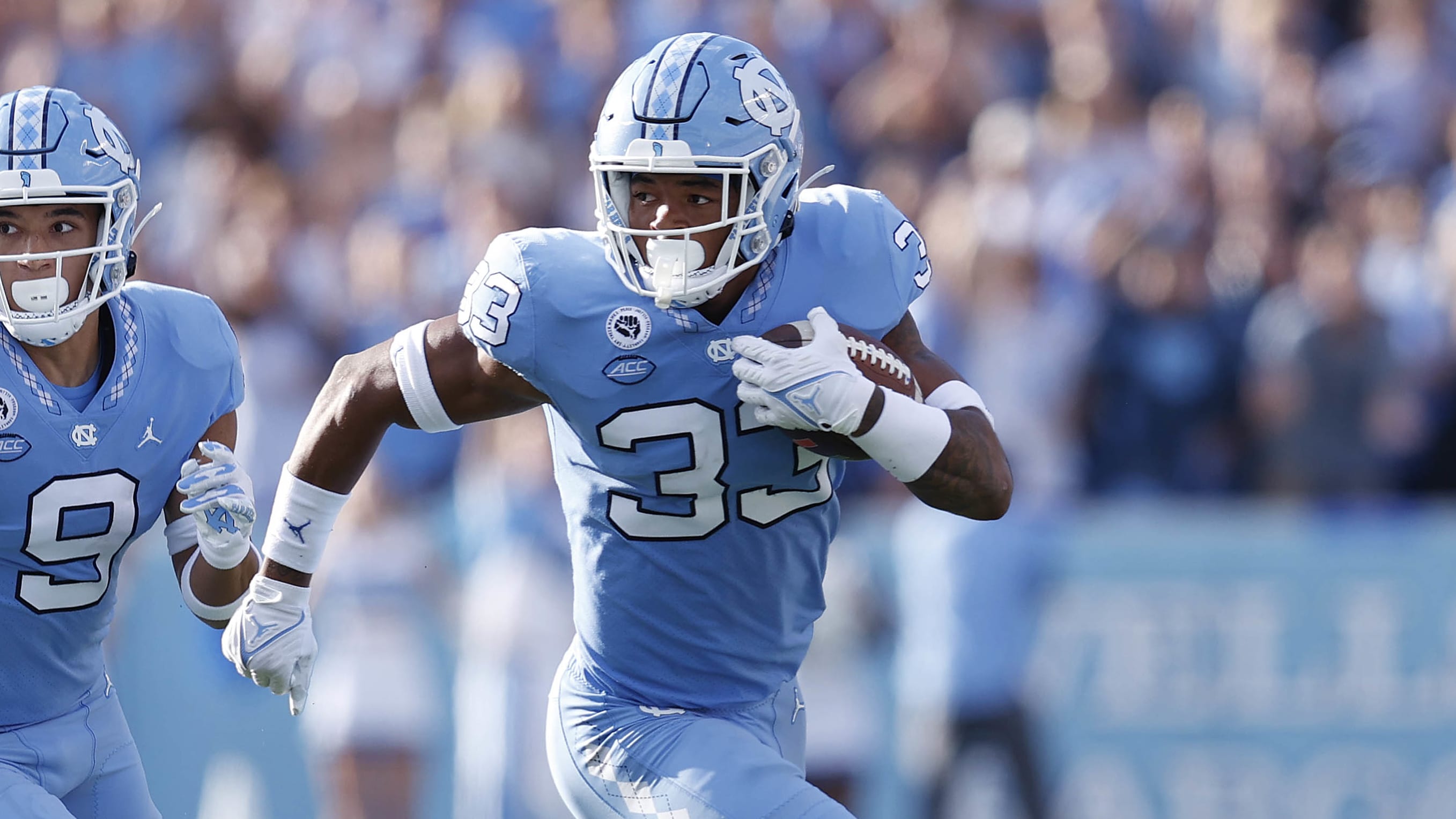Entertainment
'Where are you really from?' A Latine landmark disrupts Pasadena Playhouse's 100-year history

The pillows are fluffed, the cocktails are mixed, the enchiladas are warming in the oven. Ilana and Enrique Gomez have done everything to ready their Pasadena mansion for the arrival of their daughter’s boyfriend. But nothing could prepare them for who the person at their front door turns out to be.
In Gloria Calderón Kellett’s new play “One of the Good Ones,” this scenario leads to frank conversation, unfolding in real time, about unconscious biases, intergenerational expectations and who gets to claim Latino and American identity. (Between spit takes, hot flashes and swings at a very full piñata, that is.)
“It’s ‘Guess Who’s Coming to Dinner’ meets ‘Disgraced,’” teased director Kimberly Senior. “And even though it’s a one-act play, the second act is the conversation you’ll probably be having afterward.”
While the play’s title reflects how the onstage parents (Lana Parrilla and Carlos Gómez) view their only daughter (Isabella Gomez), it also echoes how Calderón Kellett, one of the industry’s few Latina showrunners (“One Day at a Time,” “With Love”), says she’s been received during her Hollywood career: with “zoo animal fascination with what it’s like to be a non-white man telling stories.” And the world-premiere comedy, running through April 7, is the first Latine commission in the 100-year history of the Tony-winning Pasadena Playhouse — a landmark worth celebrating, though sorely overdue for a Los Angeles theater company.
Ahead of the play’s opening night on Sunday, Calderón Kellett had a candid chat with The Times about writing Latino characters who are thriving, learning about theater from Norman Lear and making even the toughest conversations laugh-out-loud funny.
How did “One of the Good Ones” come to be?
I wanted to write something about the complexities of identity. Before the strike, I spoke to Danny [Feldman, artistic director of the Pasadena Playhouse] about the fact that, though I’ve been a [television] writer for 15 years on many shows, when I did “One Day at a Time,” all people were interested in talking about was my Latinidad. I’m happy to talk about it, because I love who I am and I’m proud of my parents and where they came from, but it’s all people wanted to talk about. And I would get it from both sides, from the white perspective and from the Latino perspective — this sort of zoo animal fascination with what it’s like to be a non-white man telling stories.
So I had to navigate being a storyteller and constantly defending your point of view in the world, which I found bizarre because it’s not something my white counterparts ever have to do. [“One Day at a Time” co-showrunner] Mike Royce was like, “Man, I just get to show up and tell stories and jokes, you have to come in with the weight of the world on your shoulders to represent your community. It’s so much heavier, what you have to do, and I see you.” I burst into tears and he hugged me.
Isabella Gomez, Carlos Gómez and Lana Parrilla in “One of the Good Ones” at the Pasadena Playhouse.
(Jeff Lorch)
The play discusses identity — Latino and American — from multiple perspectives within one family: one parent is of Puerto Rican and Mexican descent, another is Cuban with grandparents from Spain. What inspired these characters and their conversation?
Having to navigate those spaces myself. I’m a West Coast Cuban who grew up in Portland, Ore., and then San Diego. And then in Los Angeles, I was constantly being told as an actress in auditions that I’m not Latina enough, I’m not dark enough, I need more of an accent to play this Latina character. I’m literally 100% Latina! So is identity based on where you live, where your parents lived, what language you speak, what you think it’s supposed to look like?
I also wanted it to be an intergenerational conversation. Writing “One Day at a Time,” I had so many talks with my viejitos about LGBTQIA issues and using Latino/Latina/Latinx — all of that stuff, they don’t know anything about it, they think it’s all crazy. But I loved talking to them about these things, everyone asking questions and trying to understand each other. So though everyone [onstage] is both right and wrong, and though they might not get any definitive answers by the end of the conversation, that they’re able to talk about it, chip away at it and maybe, over time, they’ll get it — that’s the answer.
This discussion unfolds in real time, and though it does get heavy at times, it’s also hilarious. How did you find the funny in such complex topics?
The idea of who gets to claim an identity, that fine line between cultural appropriation and cultural appreciation, it’s so interesting! And one thing I wanted to do: there are lines in here that white people constantly say to Latino people in real life. Like, “Where are you really from?” “Some of our best friends are Latino!” We get that stuff all the time. So I purposefully wanted to see that in the mouths of the Latino characters, let this conversation unfold and have the audience be a fly on the wall in this home.
And with all storytelling, specificity is universal. Like, there wouldn’t have been anybody who walked through that front door who would’ve been good enough for their daughter, and that’s something every parent can relate to. So if you’re not Latino, there’s still going to be things in here that resonate with you. I hope the audience laughs a lot, and then talks for hours afterward. For me, that’d be the biggest win.
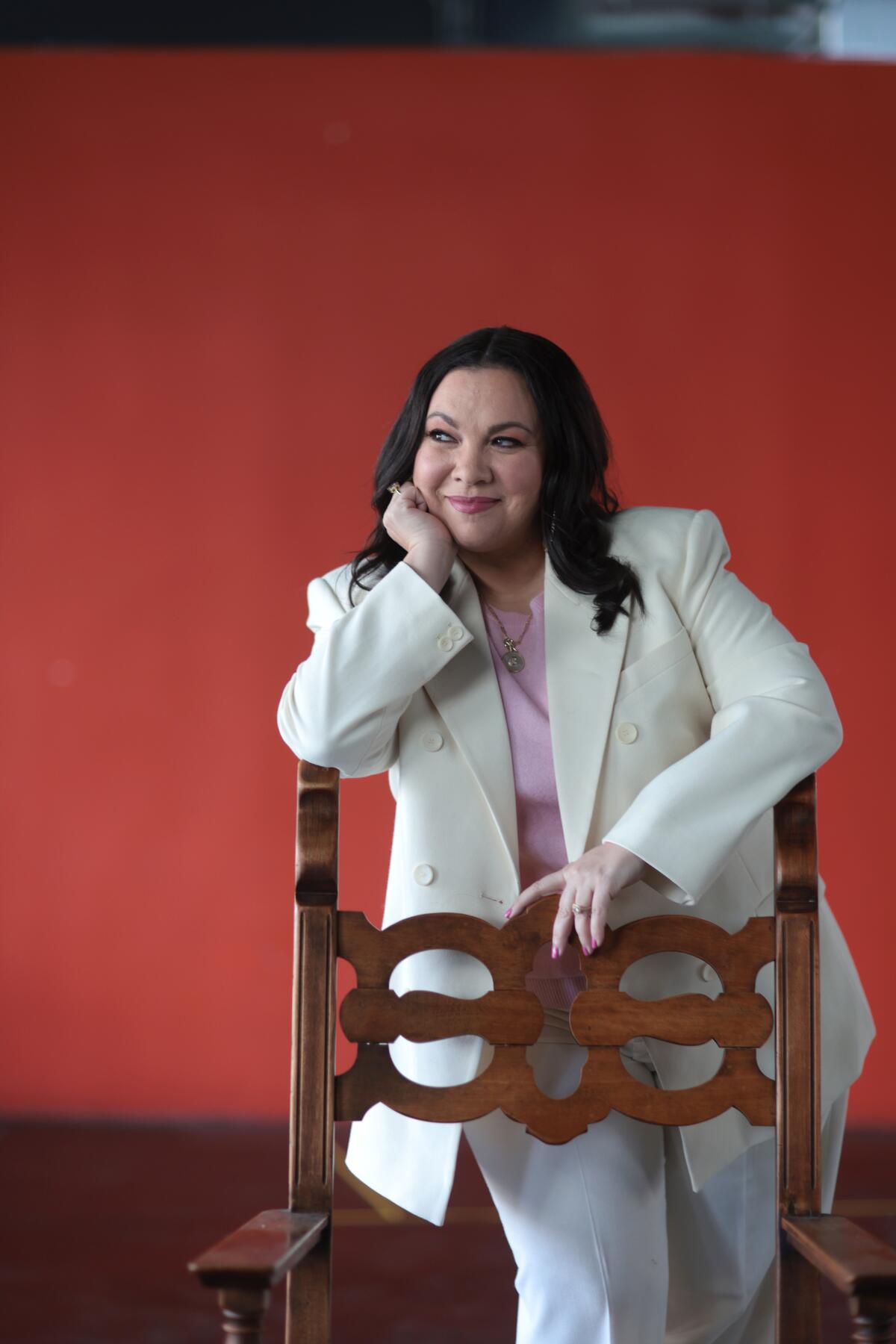
“I hope the audience laughs a lot, and then talks for hours afterward,” said Gloria Calderón Kellett.
(Myung J. Chun / Los Angeles Times)
It’s a bittersweet milestone that your play is the first Latine commission in Pasadena Playhouse’s 100-year history. So I do love that you highlight the city’s Indigenous roots in the script when matriarch Ilana says, “I was born in Mexico. It’s just not called that anymore.”
The idea of America as the “great experiment” is so interesting, and who feels entitled to this land is fascinating, because it’s not theirs either. And I just had to challenge the idea that anyone feels entitled to this place more than anyone else, with the exception of the native people who actually are from this land.
This is actually the first play I’ve written that is specifically Latino. All the plays I’ve written before were an answer to what I wasn’t finding when I was auditioning as an actor; they were mostly for myself and my friends, just existing as humans in spaces. And those plays worked well for me because they got me staffed on TV shows.
Do you feel pressure debuting your first Latino play in Los Angeles?
I know that one story can’t speak to all experiences; this is this specific family in this specific time on this specific land.
I am really proud of the fact that this play exists. Our stories are only really invested in when we are in trauma or when we are glorified drug dealers, and then that’s how people who do not know people from my community think we are, because they don’t know themselves. Latinos are 20% of the United States population, and still only 5% [of actors in leading roles], and I can’t even imagine what the numbers are for theater. I’m curious about how many Latino productions are being done, and of those productions, how many are border stories or drug narratives, and how many are just Latino people living their lives and being happy.
And the other thing is, we’re always poor — and that 100% exists, but I also know a lot of Latinos who are thriving. So it’s very important for me to show that on this land, there are Latinos living in big houses, who send their kids to college, who have thriving businesses. And yet, they still walk with a lot of these issues about identity and connection on their shoulders.
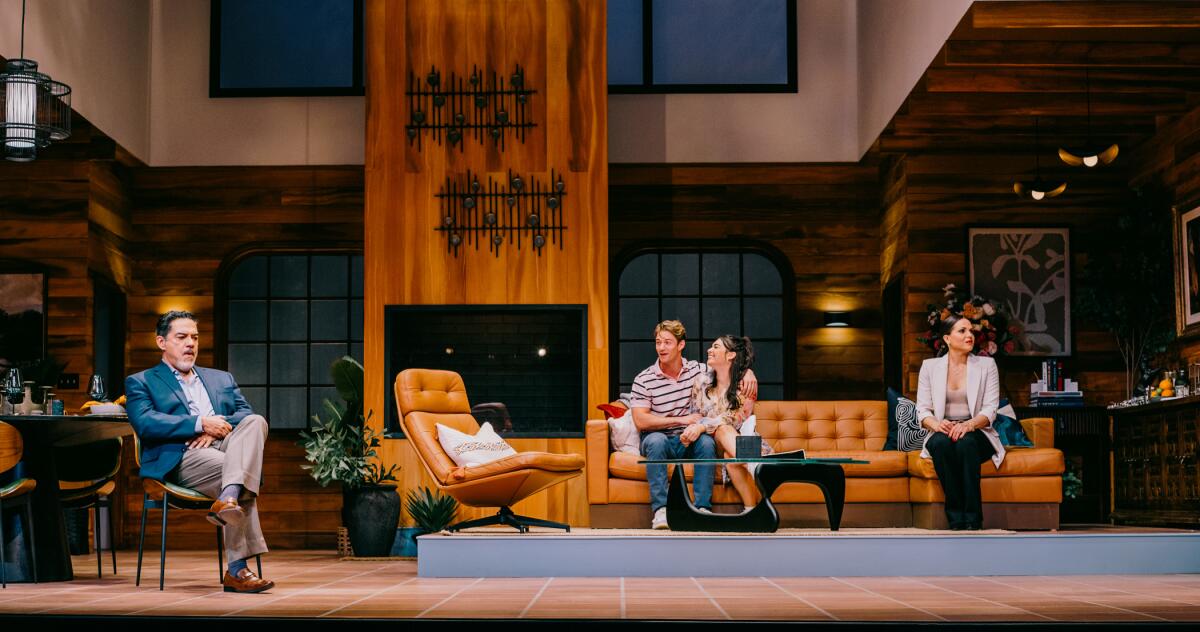
Carlos Gómez, Nico Greetham, Isabella Gomez and Lana Parrilla in “One of the Good Ones” at the Pasadena Playhouse.
(Jeff Lorch)
How have your years writing for television benefited your playwriting?
I learned so much from working with Norman Lear. Norman loved the theater, and because he wanted to bring the theater to the everyday family in their households, his multicam sitcoms were very different: the proscenium, long scenes, pages and pages with no jokes. Because it wasn’t always about the jokes, it was about the conversation. You’re there to tell a story; sometimes it’s funny, sometimes it’s not. People processing their feelings might mean acting out or silence or awkwardness; it might be scary and then funny again. Real life is all of those things. That was the type of sitcom he liked, and that’s the type of sitcom I like.
For this play, I get to sit with that at length — no scenes, one location, all in real time. It’s building the tension with the audience live and not letting them off the hook until the end.
What’s been the hardest part about writing this play?
The biggest challenge for me is the fact that there’s so much I want to say. I feel like it could be four hours long! I’m telling myself, “You don’t have to get all of it in this one play. You don’t have to fix all of it. Just tell this one story.”

“I hope this show is successful and will lead to many more stories where the focus is on the thriving, not the trauma,” said Gloria Calderón Kellett.
(Myung J. Chun / Los Angeles Times)
What is your hope for “One of the Good Ones” after this run ends?
Whether it’s a pilot or a play, I always love putting up new work, and this has been a wonderful opportunity to stretch my creative muscles. I would love to keep developing it at other theaters, and I’m hopeful that it will lead to audiences’ conversations, healing and understanding of one another.
I also think a lot about who gets to hold a microphone and tell a story. I’m trying to do it in a way that is inclusive and responsible for what I want the future to look like. So I hope this show is successful and will lead to many more stories where the focus is on the thriving, not the trauma. And I hope they come from many different points of view, because I get called a “unicorn” a lot, like I’m the only one, right? No, I promise, I’m not. There’s more of us, and we’ve got work to do.
‘One of the Good Ones’
Where: Pasadena Playhouse, 39 S. El Molino Ave., Pasadena
When: 8 p.m. Wednesdays-Fridays, 2 and 8 p.m. Saturdays, 2 p.m. Sundays. Ends April 7.
Tickets: Start at $35
Contact: (626) 356-7529 or pasadenaplayhouse.org
Running time: 1 hour, 30 minutes

Movie Reviews
Ghostbusters: Frozen Empire Movie Review: An underwhelming nostalgia bait

It is often said that the primary objective of franchise films is to evoke nostalgia in the viewers. These films serve as a reminder of the time when we first met the characters, a time when we had fun and didn’t have the adult perspective to overanalyse filmmaking style. An ideal scenario in such cases, is a sequel that takes a new approach while still retaining the warmth of the original film, thereby providing you with a refreshing yet nostalgic experience. However, Ghostbusters: Frozen Empire, the latest addition to the Ghostbusters franchise, fails to deliver in terms of novelty, instead relying solely on nostalgia.
Director: Gil Kenan
Cast: Paul Rudd, Carrie Coon, Finn Wolfhard, Mckenna Grace, Kumail Nanjiani
This fifth addition to the supernatural comedy franchise takes place three years after the events of Ghostbusters: Afterlife. The Spenglers, including Egon Spengler’s daughter Callie Spengler (Carrie Coon), her boyfriend, Gary Grooberson(Paul Rudd), her children Trevor (Finn Wolfhard) and Phoebe( Mckenna Grace), and their close friends Lucky Domingo and Podcast, move to New York City to assist Winston Zeddemore (Ernie Hudson) and Ray Stantz (Dan Aykroyd ) in reestablishing the paranormal investigation group known as Ghostbusters.
Entertainment
The differences — and similarities — between the Coachella and Stagecoach festivals

After back-to-back weekends of the Coachella Valley Music and Arts Festival, with performances from a reunited No Doubt, Tyler, the Creator, Lana Del Rey and Doja Cat (complete with an entourage of sexy Yetis), sister event the Stagecoach Country Music Festival has rolled into Indio’s Empire Polo Club.
Stagecoach, which will feature performances by Eric Church, Miranda Lambert, Morgan Wallen, Willie Nelson, Post Malone, Dwight Yoakam and others, has grown in popularity since it started in 2007. This year it sold out well in advance of the fest.
So if you’re wondering how Southern California’s two largest music festivals, compare, here’s a primer.
The music
While the lineups are vastly different, there is one artist who is spending three consecutive weekends in Indio: Carin León. The regional Mexican music star attracted crowds at Coachella’s twin weekends. (León joins a small club of artists who have played both fests, including fellow Stagecoach 2024 performers Willie Nelson, Trampled by Turtles and Post Malone, but it’s even more rare to play both fests in the same year, as Nelson has.)
While Coachella is known for plenty of pulsing EDM beats, that has begun to transfer over to Stagecoach in recent years, with Diplo’s name now branding the indoor Honkytonk dance tent that started out as a place for traditional line dancing.
The grounds
The Stagecoach footprint is noticeably smaller than Coachella’s. The VIP rose garden is not part of the fest, nor is the hulking Sahara Tent, although it can be seen in the distance.
The Mane Stage is set up 90 degrees clockwise from where Coachella’s largest stage was, but at Stagecoach there are fewer stages overall. Stagecoach‘s largest music spaces are the Mane, Palomino (Coachella’s Mojave Tent) and Diplo’s Honkytonk (Coachella’s Yuma Tent). The air-conditioned Sonora Tent has been transformed into the Bud Light Backyard, with performances throughout the weekend, but it’s not a full slate of music like it was at Coachella. Some stars who are playing early on the Mane stage, including Josh Ross, Kylie Morgan and The War and Treaty, will perform a second set at the Bud Light Backyard during the weekend. The Stagecoach-exclusive Toyota Music Den features up-and-coming artists such as Shaylen and RVSHVD.
Coachella’s Gobi Tent has been turned into the Yellowstone Dutton Ranch with meet-and-greets with cast members of “Yellowstone” and “1923” and a merch collaboration between Yellowstone and Stagecoach.
Stagecoach also has VIP seated and standing sections, with the general admission fans being further out on the field for the Mane stage, and fans can bring in lawn chairs, which is a no-no for Coachella. The other stages are like Coachella with first-come, first-to-get-close-to-the-stage access.
Coachella’s craft-beer barn area has been renamed for the Mayor of Flavortown himself, Guy Fieri, and the food stalls from the last two weekends have been replaced with a large RV and area for Fieri and friends’ cooking demos all weekend long. Perhaps the best detail of the area: a smoker with Flavortown branding that has a metal sculpture of a bull’s head with red eyes.
Both festivals offer the standards of pizza and chicken tenders, but many of the L.A. restaurants that were at Coachella both weekends have decamped. While you can find some plant-based options, they aren’t as plentiful as at Coachella, while Stagecoach easily has the better barbecue game.
Outside of the main festival grounds, Stagecoach allows RV camping and you can only access the campgrounds if you are camping.
There’s also a space at Stagecoach for demonstrations with the Compton Cowboys.
Oh, and that lush green grass you saw on everyone’s Instagram during Coachella? It’s mostly gone now.
The art
While the rainbow Spectra tower is a permanent installation on the grounds at this point, most of the large installation art that created the landscape of Coachella is gone.
However, not far from Spectra is Mismo, an art installation of colorful paisley teardrop sculptures by Sofia Enriquez that was originally part of the program at Coachella 2019.
Stagecoach also has a couple of pieces of large country-themed art, including a horse sculpture and a cowboy boot.
The Ferris wheel is not quite art but definitely a landmark, and it remains in the same spot for both fests.
The stuff
Stagecoach is full of free stuff. If you have T-Mobile you can get a free lawn chair at their activation. The Bud Light Backyard let fans pick up a custom koozie with a choice of four designs. There are also free goodies at the Toyota Music den, including the favorite Stagecoach bandanna.
At Coachella, there were Neutrogena sunscreen kiosks where you could lather on some free sunblock.
The style
Cowboy hats, boots and fringe were favorite fashion choices at both fests in 2024, but the wild and colorful fashionistas of Coachella aren’t posing around the field at Stagecoach. There is, however, much more plaid, and gear covered in American flag prints.
Mullets are definitely back, with Peso Pluma’s Edgar style the most prominent at Coachella. At Stagecoach, you see some young people with mullets but you still occasionally spot someone who has been rocking the style since the early ’90s.
The one accessory that you will see at both? Bandannas, not just for fashion but a must to try to stave off the festival cough with the gusty winds blowing dust around the site. That’s a souvenir nobody wants to take back with them.
Movie Reviews
Film Review: Eye for an Eye 2 (2024) by Yang Bing Jia
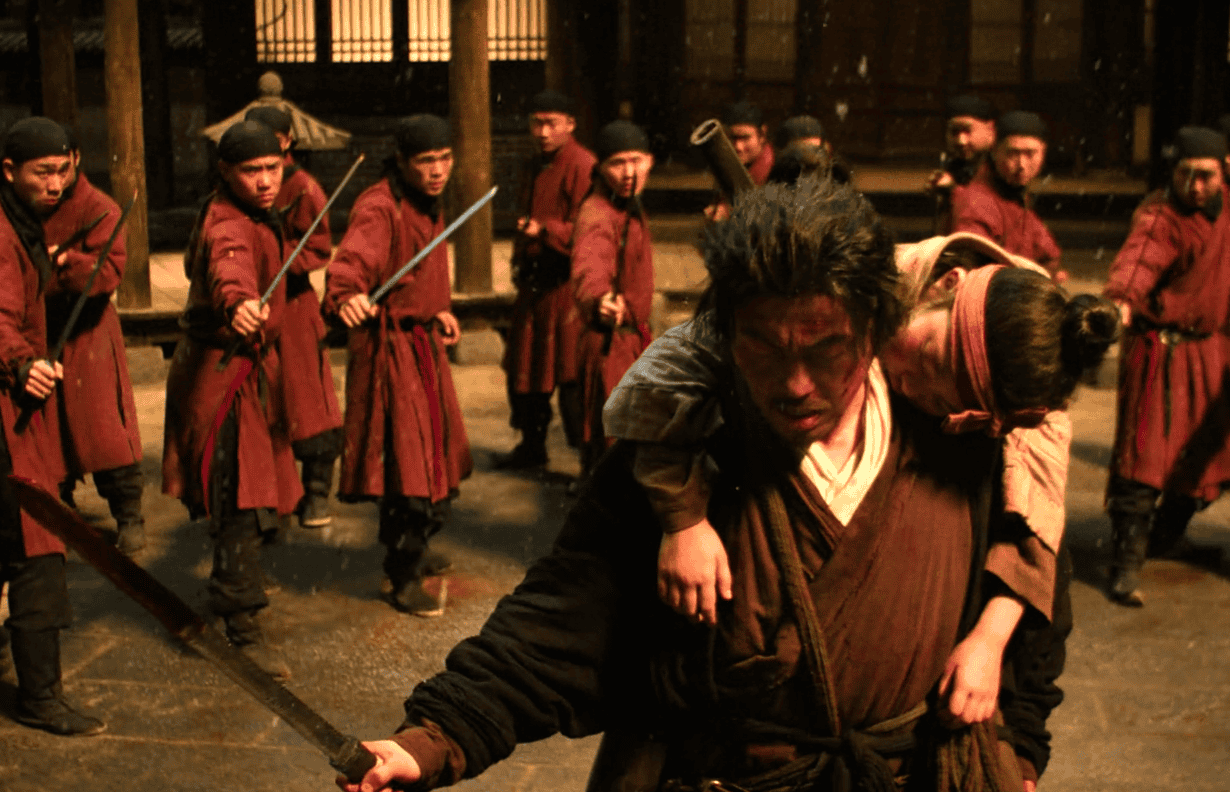
“A blind man, a kid. You claim to be bounty hunters. Right?”
A surprise hit after its release on various streaming platforms, director and writer Yang’s short online wuxia film “Eye for an Eye: The Blind Swordsman” (2023) starring Xie Miao as the protagonist went on to generate a fair amount of attention both in Mainland China and overseas. Therefore it is inevitable that a sequel soon follows with both Yang and Xie returning. Though scheduled for a wilder cinema release, the much anticipated and a longer follow-up still ended up streaming on iQIYI.
This second installment kicks off in Youzhou during the Tang Dynasty. Believing that five fugitives are hiding in a gambling den, blind swordsman Cheng Xia Zi shows up to arrest them. Naturally, they try to fight their way out but of course they are no match for the lethal bounty hunter. Apparently, Cheng is trying to make as much money as possible so he can retire in Chang An, his old hometown.
Meanwhile, in another part of town, a pair of homeless orphans, Zhang Xiao Yu and her little brother Xiao Cao, are stealing food and are caught up in a confrontation between ruthless officer Li Jiu Lang and his rebels. The merciless Li kills the defenseless rebels, Zhang manages to escape but her brother is not that lucky. While on the run, she accidentally bumps into the grumpy Cheng who reluctantly shelters her. After a while, they start to bond and eventually work as a team to bring the cold-blooded Li and his little empire down.
Yang’s sequel plays like a proper wuxia film probably because of its longer running time which allows him to further develop the main lead characters and the dramatic elements. A subplot that concentrates on the orphan Zhang Xiao Yu, played by Yang En You, a traumatized little girl who is obsessed with revenge after the tragic death of her brother. The bond between her and Blind Cheng which takes on centerstage is engaging and not rushed. However, it seems like director Yang is doing a Zatoichi style adventure with a bit of Lone Wolf and Cub thrown in for good measure at times.
Visually the film looks great, especially the outdoor location of rolling hills, forests and mountain ranges. Besides, the detailed town buildings plus their interiors all look lived in and authentic. The fast and crisp fight sequences designed by action choreographers Qin Peng Fei and Du Xiao Hui are impressive, though quite brutal. Also, the fight which features a thug wielding a pair of flaming sword looks interesting and fun, but it is borrowed from Su Chao Pin and John Woo’s “Reign of Assassins” (2010). Though epic, the end fight between Cheng and three hundred guards seems too far fetched and rushed. However, Yang’s use of split screens during the film’s lighter moments is refreshing.
Actor and martial arts champion Xia Miao, born in Beijing, is no stranger to Asian action films who appears in more than thirty films and TV series. He started his film career as a child actor alongside Jet Li in “The New Legend of Shaolin” (1994) and again in “My Father is a Hero” (1995), these films gained him a reputation both overseas and locally. After that he takes a break to study and then makes a comeback in the TV series “Legend of the Shaolin Temple” (2006) and “The Kung Fu Master” (2010). Xia Miao’s portrayal of the blind bounty hunter Cheng is impressive and his moves are equally smooth and convincing during the many fight sequences.
The introduction of a second lead character, the vengeful child, Zhang Xiao Yu (Yang En You) is a nice touch. Child star Yang is impressive and shines as the orphan Zhang, as she effortlessly tackles the emotional and dramatic moments of the film. In addition, her interchange-like bickering and the playful moments with swordsman Cheng are interesting to watch and a nice distraction from the otherwise violent fight scenes, besides adding the much needed emotional connection. Furthermore, Hung Tao is adequately evil and memorable playing the cruel officer Li Jiu Lang.
Even though the storyline of “Eye for an Eye 2” is predictable and familiar, it is still impressive and satisfying production. Besides, the well written lead characters are a plus, and when topped off with the well choregraphed action and engaging visuals, it all makes for a balanced sequel.
-

 Movie Reviews1 week ago
Movie Reviews1 week agoMovie Review: The American Society of Magical Negroes
-

 World1 week ago
World1 week agoIf not Ursula, then who? Seven in the wings for Commission top job
-

 Kentucky1 week ago
Kentucky1 week agoKentucky first lady visits Fort Knox schools in honor of Month of the Military Child
-

 World1 week ago
World1 week ago'You are a criminal!' Heckler blasts von der Leyen's stance on Israel
-

 Movie Reviews1 week ago
Movie Reviews1 week agoPon Ondru Kanden Movie Review: This vanilla rom-com wastes a good premise with hasty execution
-

 Politics1 week ago
Politics1 week agoTrump trial: Jury selection to resume in New York City for 3rd day in former president's trial
-

 News1 week ago
News1 week agoHouse passes bill requiring warrant to purchase data from third parties
-
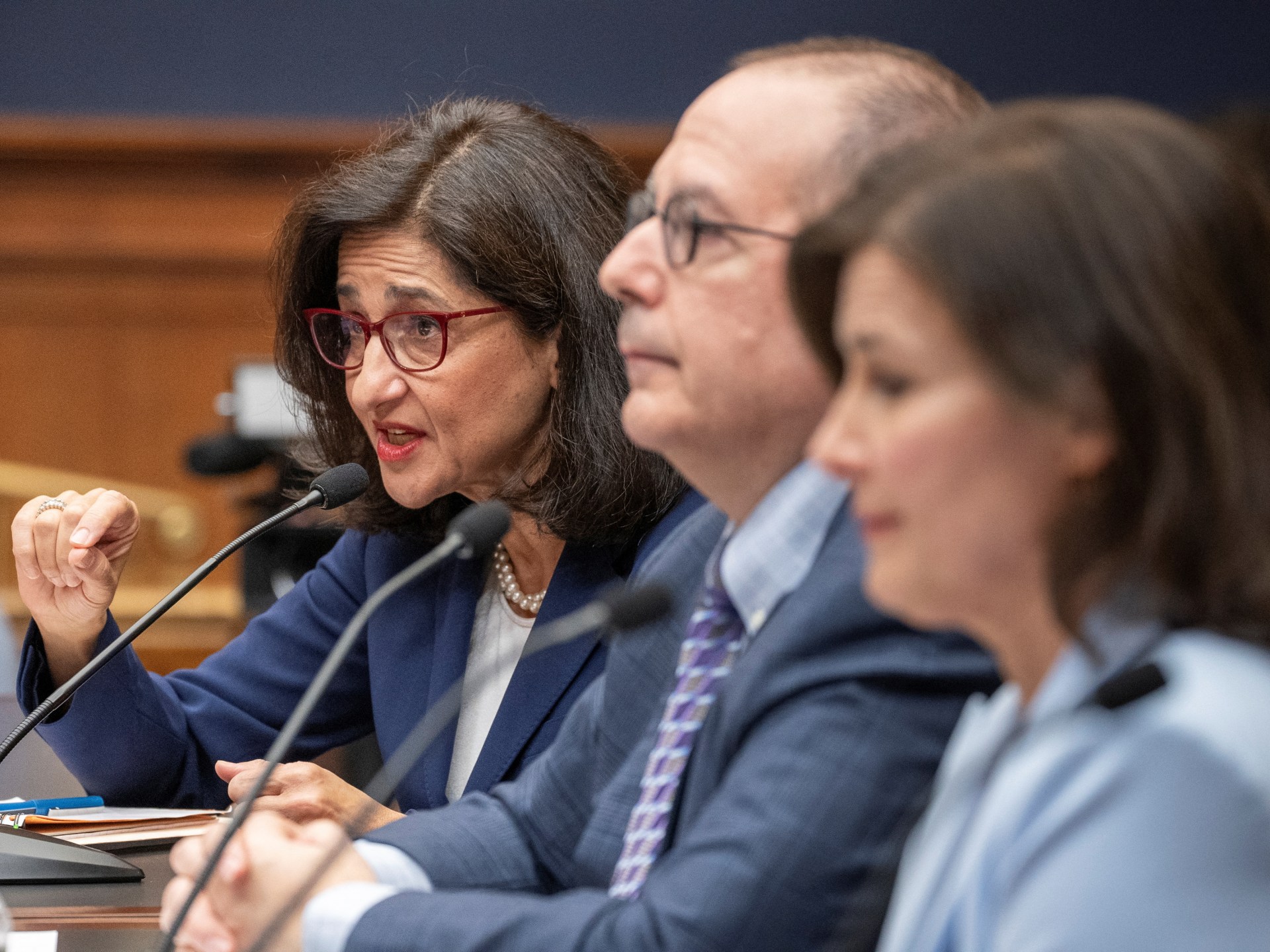
 World1 week ago
World1 week agoColumbia University leaders face scrutiny over anti-Semitism on campus




